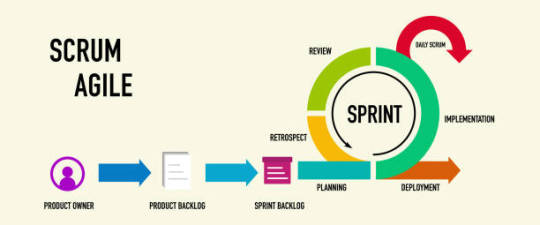#Agile Transformation
Text
Self-acceptance
Get rid of this self-sabotage, break the generic plastic perfect mold, break the bias in yourself, and lead the way to others.
When we got this image we immediately thougth, skip this photo, the veins of my hands are popping out. What would the world think about them!
But let me tell you this. After years of climbing, canicrossing, boxing, facing anxiety attacks, holding tight, letting go, playing music, painting, and writing stories. These are strong woman, dreamer warrior hands. They share much more lessons in those…

View On WordPress
#agile transformation#agiletransformation#book and wine#books and wine#break the bias#breakthebias#el piloto de tu vida#Growth#personal growth#the pilot of your life
20 notes
·
View notes
Text
Srikanth Goduru's 4 Tips on Agile Product Management
Discover Srikanth Goduru's four transformative tips for Agile product management. Prioritize customer value, embrace iterative development, foster team collaboration, and continuously refine product strategy. By aligning efforts with customer needs, delivering incrementally, fostering collaboration, and staying responsive to market dynamics, teams can maximize value delivery and succeed in their product development endeavors. With Sri Goduru's insights as a guiding beacon, organizations can navigate the complexities of Agile product management with confidence and clarity, ultimately driving innovation and customer satisfaction.
#srikanth goduru#sri goduru#agile project management#agile methodology#agile coaching#agile transformation
0 notes
Text
Navigating the Agile Leadership Journey.
Are you ready to dive into the world of agile leadership? If you're passionate about evolving your leadership style to steer through today's dynamic business challenges, check out our latest blog.

We're exploring how mastering agile techniques can transform your organization into a powerhouse of success and innovation.
Don't miss out on key insights from our Agile Leadership Essentials course—it could be a game changer for your professional growth!
🔗 https://www.advisedskills.com/about/news/485-mastering-agile-leadership-bringing-success-to-agile-transformations
#AgileLeadership #LeadershipDevelopment #AgileTransformation #BusinessAgility #LeadershipSkills
0 notes
Text
Embark on the journey to Agile greatness!
Discover the secrets of successful Agile transformation and pave the way to becoming a truly Agile organization.
0 notes
Text
Benefits of Agile in Digital Transformation
Faster time to market
Increased adaptability
Improved collaboration
Increased customer focus
Better risk management
Improved efficiency
Collect data and drive insights
#technology#digital transformation#tech#it services#mobile app developers#software development#technology trends#product development service#agile transformation#agile#agileframework
0 notes
Text
Value Stream Management for Agility
In today’s fast-paced business landscape, the need for agility has never been more crucial. Whether you’re a small startup or a large corporation, the ability to adapt and respond quickly to changing market conditions is the key to success. Value stream management, a concept rooted in lean principles, has emerged as a powerful tool to drive agility in organizations of all sizes.
What is Value…

View On WordPress
0 notes
Text
Is my job safe against AI? ChatGPT vs Scrum Master & Agile Coach
In an era defined by rapid technological advancements, the roles of Scrum Masters and Agile Coaches are not immune to the impact of artificial intelligence (AI). As organizations strive to optimize their processes and embrace agile methodologies, it’s natural to wonder if these roles are at risk. However, a closer look reveals that Scrum Masters and Agile Coaches possess unique qualities that are…

View On WordPress
#adaptability#Agile Coach#Agile Methodologies#Agile Processes#Agile Transformation#AI Impact#Automation#Continuous Improvement#Data Analysis#Emotional Intelligence#Human-Centered#Interpersonal Skills#leadership#problem-solving#Scrum Master#Team Collaboration#Technology
0 notes
Text
🔍 Embrace Enterprise Agile: Learn from Seven Lessons in Agile Transformation - Download Now!
Embark on a journey towards Enterprise Agile excellence with our illuminating white paper. 🚀🔒
📌 As organizations adapt to dynamic markets, Enterprise Agile has become a beacon of innovation and efficiency. Dive into our comprehensive white paper to uncover the seven pivotal lessons learned in Agile transformation. Discover how to overcome challenges and unlock the full potential of Agile at scale.
🔬 Key Highlights:
- Unveil real-world insights from successful Enterprise Agile implementations.
- Explore strategies to align Agile methodologies with organizational goals.
- Learn how to foster collaboration, flexibility, and rapid value delivery.
- Gain actionable steps to make your Agile transformation seamless.
🚀 Download our white paper today to equip your organization with the wisdom of experience and pave the way for an Agile future that fuels growth.
📥 Download Now - Transitioning to Enterprise Agile: Seven Valuable Lessons from the Agile Journey (complianceg.com)
0 notes
Text
Agile for Healthcare with Benzne: Streamlining Processes and Enhancing Patient Care
Agile for Healthcare have revolutionized the software development industry, but their benefits extend beyond IT services. In this blog post, we will explore how Benzne's approach to Agile can transform healthcare organizations, improving processes and ultimately enhancing patient care.
Spotify Agile with Benzne: Harmonizing Healthcare Operations
The Spotify Agile model has gained recognition for its success in the music streaming industry, but it can also be applied to healthcare settings with the help of Benzne. By adopting a squad-based structure and fostering cross-functional collaboration, healthcare organizations can streamline operations and improve communication between different departments. This enables faster decision-making and more efficient delivery of patient care.

Agile for IT Services with Benzne: Optimizing Technology Solutions
In today's digital era, technology plays a crucial role in delivering quality healthcare services. With Benzne's expertise in agile practices specifically tailored Agile for IT services within the healthcare sector, organizations can effectively manage complex projects such as implementing electronic health records (EHRs) or developing telemedicine platforms. By breaking down projects into smaller increments known as sprints and regularly gathering feedback from stakeholders, teams can ensure that solutions are aligned with user needs while adapting to changing requirements efficiently.
Agile Approach for Enhanced Patient Care at Every Stage
Adopting an agile mindset allows healthcare providers to prioritize patient-centricity throughout every stage of care delivery from diagnosis to treatment planning and follow-up procedures. By embracing iterative approaches like Scrum or Kanban boards, medical professionals collaborate closely with patients, ensuring that individual needs are met promptly while continuously refining treatment plans based on evolving circumstances or new research findings.
Conclusion
Benzne's application of agile methodologies is not limited to traditional software development scenarios; it extends seamlessly into sectors such as healthcare where optimized processes directly impact patient care outcomes positively. Embracing frameworks like Spotify Agile and leveraging Benzne's expertise in agile IT services, healthcare organizations can unlock new levels of efficiency, collaboration, and patient-centricity. By implementing these practices, healthcare providers can transform their operations to meet the ever-evolving needs of patients while delivering high-quality care effectively.
Know More:- Benzne.com
0 notes
Text
Why agile teams should care about documentation
The way teams work together is constantly changing, and agile teams are at the forefront of this revolution. Agile teams allow for greater collaboration and rapid iteration, but one challenge that often stands in their way is documentation. How can teams make sure their documentation is accurate and up-to-date while still using an agile approach? In this article, we'll explore why agile teams should care about documentation, the benefits of documenting with an agile mindset, how to use automation to strengthen your agile documentation process, and best practices for making it a success. By following these tips from Agile Digest, you can ensure your team's documentation reflects the fast pace of agile development.

The challenge of agile teams and documentation
Agile teams can be incredibly productive, but documentation is still an important part of the process. Documentation not only helps track project progress and milestones, it also allows stakeholders to have a better understanding of what is being developed. Unfortunately, the fast-paced nature of agile development makes it difficult to find the time and resources for effective documentation. To address this challenge, teams should ensure they have a clear understanding of their objectives before beginning work and use automation tools whenever possible. Additionally, regular reviews with stakeholders should be held to guarantee that everyone is content with the accuracy of the documentations created by agile teams. By making sure these steps are taken beforehand, agile teams can create successful projects as well as accurate documentation that accurately reflects their efforts.
The benefits of documenting with an agile mindset
Documenting is an essential component of any venture, particularly for agile teams. Keeping accurate records aids in guaranteeing that everyone has a shared comprehension of the undertaking or task and motivates collaboration between crew members. Documentation can also assist in pinpointing potential issues before they arise, as well as ensuring all participants are up-to-date with the project's development.
Agile documentation encourages continuous enhancement throughout the process and allows teams to detail their successes and failures. This form of transparency permits groups to utilize their slip-ups as learning chances, leading to more fruitful projects down the road. Agile documentation also assists teams swiftly incorporate modifications to processes without having to go through a lengthy cycle of approvals.
The secret to successful agile documentation lies in creating meaningful documents that are simple for everybody engaged in a job or task to access and comprehend rapidly. To accomplish this, it is vital that all stakeholders agree on what should be documented, when something should be documented, and how it should be recorded. Automation tools can help streamline this process by providing templates for documenting tasks and producing repeatable procedures so that no step is neglected when generating new documents.
It's also crucial for crews periodically assess their documents with stakeholder input from various departments and other team members. This helps guarantee correctness and completeness of all documents generated and guarantees everyone remains informed about the current state of each document or task being worked on at any given time.
By adhering to these best practices for agile documentation, teams can create precise and up-to-date records which will enable them to succeed in whatever assignment or task they are working on together.
Waterfall documentation makes your job harder
While waterfall documentation may be the more traditional approach to documenting projects, it is not always the most effective. Agile teams should consider utilizing an agile document approach to streamline their process and save time while still producing quality work that meets customer needs. This will help them maximize their productivity and reach their goals faster, allowing them to focus on creating a high-quality product instead of spending hours painstakingly writing detailed reports.
How to use automation to strengthen your agile documentation process
Automation can be a great way to strengthen your agile documentation process. It can help streamline the process, save time, and still produce quality work that meets customer needs. Automation tools are available that provide templates for creating documents quickly, as well as tracking and monitoring usage.
Third-party automation tools are available that can be tailored to meet the needs of agile teams. These tools allow teams to create structured documents with the right content for their specific project and team objectives. Automation also helps with managing versions of documentation, ensuring everyone is working off the same version and reducing duplication of effort.
When deciding which parts of the agile documentation process should be automated, it is important to identify tasks that are applicable to agile methodologies and will provide value in terms of time savings or accuracy of data collected. A checklist of tasks that should be automated can include; creating new documents quickly from templates, documenting changes made during sprints using a change log, tracking document versions with a revision history, validating user inputs using form validation rules and providing context-sensitive help when needed.
Once you have identified which parts of your processes should be automated, you must then implement these automation tools into your existing system, following best practices such as test driven development (TDD) to ensure successful implementation. Once implemented it is important to document how the automation works so other users know how it functions and its purpose within the overall system.
Finally it is essential that you monitor usage metrics regularly to ensure automation tools are operating correctly and meeting expectations. Doing this will allow teams to measure success or failure against targets set out in their objectives from the start. By doing this regularly teams can adjust their processes accordingly so they remain up-to-date with customer needs while maximizing efficiency through automation tools where possible.
Best practices for making agile documentation a success
For an agile team to achieve success with their documentation, it is important to take a proactive approach and adhere to best practices. This includes understanding the scope of the documentation, making use of templates for consistency, scheduling reviews, collaborating on document creation and monitoring usage metrics. Doing so will ensure all documents are accurate and up-to-date while also providing valuable insight into customer preferences. Automation tools such as Dialpad can increase efficiency by providing ready-made templates for quick setup and easy editing. By following these steps, teams will be able to produce high quality documents quickly without compromising time or resources elsewhere in order to meet customer needs every time.
0 notes
Text
Analysis traceability
When projects follow a linear path, and the scope remains relatively stable, it becomes more straightforward to define the scope of our analysis. In such cases, we can more easily identify the parameters and variables that need to be considered, allowing for a more focused approach to our analytical process.
However, when the focus shifts from larger end-to-end projects to smaller, more…
View On WordPress
0 notes
Text
Unlock Efficiency and Thrive in Today's Business Landscape with Agile Transformation
Are you tired of seeing projects and processes in your organization take weeks or even months to complete? Do you want to increase productivity and adapt to rapidly changing market demands? Look no further than the power of Agile transformation.

In this blog post, we delve into the world of Agile transformation and uncover the key strategies and benefits that can lead your organization to success.
Read the full article here: https://www.advisedskills.com/about/news/478-unlock-efficiency-the-power-of-agile-transformation-in-your-organization
#agile #transformation #projectmanagement #efficiency #business #success
1 note
·
View note
Text
Benefits of Agile Transformation
Agile Transformation refers to the process of inculcating agile methodologies in people, process, and technology in an organization. Promoting a culture of conscious attempt to follow agile principles in all aspects. There are undeniable benefits of this business excellence model, and a few are discussed below:
Promptness: Breaking tasks into smaller parts makes it more manageable and faster to deliver, these are referred to as sprints. Doing this iteratively and encouraging regular feedback and adjustments leads to quick delivery.
Customer Satisfaction: An organization has internal as well as external customers. Involving stakeholders in gaining feedback and suggestions helps in adaptation to change requirements and meet their expectations better.
Internal collaboration & communication: Agile transformation promotes a team that is highly motivated and charged to work towards collective good in the organization. They make a conscious effort to attain the goals of the organization by cross-functional team interactions and improved communication.
Increased productivity & efficiency: Teams can identify bottlenecks and inefficiencies. Process improvement opportunities can be addressed by daily stand-up meetings and regular sprint reviews. This leads to increased productivity and efficiency,
Enhanced quality of deliverables: There is no point if your deliverables do not adhere to the standard quality, quick and shoddy work leads to cost of poor quality. Continuous testing, quality assurance leads to early detection of issues, which enhances the quality of deliverables.
It is important to note that many organizations fail to achieve their desired goals due to a poorly managed initiative. They miss deadlines and often deviate from the purpose. Therefore, it is best to be led by an expert partner. There are a few big players in the Indian market that can help you do so. I recently came across Grant Thornton Bharat’s Business Excellence services in a LinkedIn post. Agile Quality Assurance (AQuA) is a relevant key solution for businesses looking for handholding in their agile journey.
0 notes
Text

Pow you messed with the Wreckers. Or something haha
Listen I don’t have a type. BUT SOMEHOW every time I find and add a character to my favorites, he turns out to be a wrecker. My best theory - I have a built-in wrecker radar~
#like#seriously#oh this anime samurai is funny and cool#i wonder what is his backstor….ah#he was a Wrecker cool#hmm blue sassy speedster celebrity?#Wait…why is he playing Go with anime samurai?? are they suddenly roommates or…ah he is also Wrecker wow#didn’t expect that#well at least they are both really fast agile and stuff#makes sense#okay let’s see#ooh funny autistic scientist microscope#I wonder what was he doing before mtmte. He must be…. a h#u n d e r s t o o d#ahahahahha#transformers#maccadam#mtmte#blurr#perceptor#drift#funny story. Drift Blurr and Perceptor…like…didn’t interact with each other during mtmte…..at all.#so when I went reading about wreckers after reading mtmte#it was really big surprise aahahahah#Drift and Blurr playing Go while Percy chilling in a giant fucking jar in a next room#me: what kind of crossover is this???#also#I love mtmte with all my heart but oh my god it didn’t show me Drift-Percy duo at all#they had such an epic friendship#tapa if you are reading this - it’s happening in All Hail Megatron hehe
3K notes
·
View notes
Text
Gleecus explores digital transformation trends that will create significant impact for the year 2023 and shape the transformation strategies.
#digital transformation#2023 trends#technology trends#ai technology#technology#machine learning#cloud computing#agile transformation#augmented reality
0 notes
Text
Agile Transformation: How To Shape Your Business And Yield Real Value?
Teams are where effective agile changes begin. After using agile approaches, the productivity of your staff will be influenced by how quickly and effectively their workplace runs.
Teams that work independently can only make so much of an impact. Departments must work together to deliver value if agility is to be achieved with the speed and effectiveness it promises.
Silos must function with an end-to-end value mentality in order to fully realize their collaborative potential. On top of this, agile processes and objectives can be developed and released.
Organizations must allow value-based thinking to lead them towards a new way of working if they are to be successful in this phase of the change.
Silos-based Thinking Hinders Organizational Performance
Organizations typically segment themselves into departments based on areas of specialization including sales, marketing, operations, and information technology.
These silos cooperate to provide value overall, although they are frequently controlled by department-specific goals.
Teams lose the chance to collaborate to optimize the entire value chain by creating their own unique sets of objectives and procedures.
Organizations may find it challenging to jointly pivot or quickly launch new items in this fragmented market. Collaboration from beginning to end is essential for success.
To overcome this compartmentalized thinking and realize the full potential of your firm, connect the dots between divisions and direct them toward overarching business objectives. Collaboration from beginning to end is essential for success.
Departmental Transformation Challenges
Change is only consistent in the fact that it is never simple. Three issues firms must deal with during this stage of their transition are detailed below, along with solutions that will make your teams successful.
Challenge #1: Using virtual organizations to combat the silo mentality
Dismantling silos can be a difficult task. Many businesses make the error of reorganizing all at once, which frequently leads to a protracted transition that takes too long to complete. An agile mindset is essential.
Modifications to the structure are simpler to implement once agile methodologies have been absorbed. To promote this mindset without the upheaval of reorganization, build up a virtual organization.
Traditional responsibilities are still there in a virtual organization, but value has been established as the focal point. Ask teams to collaborate beyond silo barriers in order to accomplish the organization’s final goals.
By blending well-known segregated KPIs with fresh measurements that track your progress toward end-to-end business objectives, you can reinforce this end-to-end approach.
Traditional KPIs: These measure things like sales and response rates to campaigns. There is no immediate need to eliminate these because they are crucial performance indicators that now assist your teams in defining success.
Add new measurements that gauge the entire business value as new KPIs. These metrics should monitor operations that contribute to value creation generally, such as profitable operations, sustainable growth, and customer satisfaction.
Once adopting a hybrid model is second nature, decide where to make structural changes by letting agile thinking lead the way.
To achieve this shift, top-level leadership must be committed to holding silo managers accountable.
Even though it’s not part of the standard procedure, asking for a direct report enables you to get beyond obstacles and assess their contribution to value generation.
The idea that every department contributes to company success will be reinforced by bringing silos together in pursuit of shared achievement.
Challenge #2: Neglecting to concentrate on end-to-end optimization
Working together across silos is crucial to bettering your organization’s ability to implement change, as well as to achieve goals more successfully.
The only real approach to increase agility in your business is to continuously enhance its capacity for managing change.
But progress within the team itself is only going to get you so far. The production process is typically slowed down by bottlenecks that are situated between teams and silos.
Most businesses overlook this crucial aspect of agility in the flurry of restructuring and production cycles.
We must build on our successes from the first challenge to combat this. Organizations need to focus on the ultimate objective while also keeping an eye on how quickly things are changing along the entire value chain. A third group of KPIs can be used to illustrate this:
New indicators that gauge the organization’s capacity for change make up the third set of KPIs. Time-to-market, frequency, cost, and failure rate of changes are some metrics that are frequently utilized.
Enhancing your end-to-end agility quickly can assist avoid silo sub-optimization. Silos can realize their potential for collaboration and value creation within the company by working together.
Challenge #3: Allowing data to drive an experimental mindset
Organizations must translate performance into measurements that can be followed over time in order to make sure teams are working towards common objectives.
When goals are specific and measurable, departments can more readily share them.
It’s hardly surprising that many firms struggle to successfully manage and use this information in our data-rich world.
While leveraging data to guide your operations is a fundamental component of an agile workflow, many businesses make the mistake of spending a lot of time and money creating the ideal dashboard before really using their data.
You’re flying blind while this technological refurbishment is taking place, though. You need some form of data intake to be able to react quickly.
Even if the data isn’t perfect, successful firms use what they have. There is a lot of important data that is simple to get and measure because of digitalization.
Consider how your conversion rate can be used to assess the performance of your entire client experience.
This might assist you in figuring out whether your conversion rate is improving, declining, or remaining stable.
Your higher-level data will be useful in identifying the complex regions that affect that conversion rate.
However, as you’re fine-tuning your metrics, understanding the overall value this approach is bringing to your firm helps point you in the correct way.
What makes agile transformations successful?
Your judgments on value creation will be guided by the data you gather. To make wise judgments that will propel you toward success, you must have faith in this data.
When it comes to guiding their employees, many leaders are used to relying on their “gut feeling” as the main indicator.
Managers must, however, become more scientific in their analysis of the data as real-world insights become more widely available.
Leaders must accept the figures as an unbiased source of information and, like scientists, place more faith in them than in their presumptions.
These metrics should develop into reliable insights that guide your decisions once data points that measure actual value for the firm have been identified.
Overcoming these obstacles may enable your firm to adopt more effective working methods. A utility firm visited Kilowott in 2015 with the intention of adopting a new digital approach. The plan was developed, however it was never implemented and produced no results.
The customer returned five years later with renewed backing for what was now seen as an essential move.
This time, instead of beginning with strategic planning, they gathered all the departments to discuss how each contributed to the overall operation of the company.
The emphasis shifted from adopting a solely digital viewpoint to defining organizational value and using this as a foundation for developing procedures.
Silos were challenged throughout the workshop to come up with fresh approaches to working that would result in a value chain that was more seamless.
Teams’ perspectives changed when they understood that removing barriers between silos would improve collaboration.
They were able to orient themselves towards a shared objective and take actions in the direction of accomplishing it by changing their perspective to concentrate on what the teams could accomplish together.
The company chose a hybrid method of operation based on the full value chain. The emphasis switched from maximizing the value of their operation as a whole to increasing the total value of individual silos working to meet departmental goals.
To do this, cross-functional multidisciplinary teams had to be formed in order to improve the flow of new business and customer assistance.
The business was able to bridge gaps between silos and work more productively to generate more value overall because of this end-to-end approach.
They are already observing effects from the ongoing change thanks to new KPIs that are being used to gauge value creation.
Key learnings to take with you in your own transformation
We have gathered important insights on what makes a successful change as a result of our years of experience helping them.
Applying the following principles as your organization embraces departmental agility will help position it for success.
Make sure top leadership has approved your request. Although transformations can begin from the ground up, they will never be fully realized without senior leadership’s strong sense of direction and commitment to change.
The importance of the change that is being made must be supported by the decision-makers, who must see it as an essential step in achieving success in the future.
Make connections between silos. The greatest effective change frequently results from gathering your departments in one place (or video call).
Bringing them together to develop fresh approaches to collaboration might help your firm as a whole become more effective and flexible in attaining objectives.
Put a focus on shared success. Every department must contribute to the creation of end-to-end value, making success something that belongs to everyone.
The KPIs ought to reflect this as well. You don’t need to entirely reorganize, but introducing a measure that monitors departments’ capacity to collaborate and generate value alongside your current KPIs will acknowledge leadership support and inspire people to move in the direction of change.
End-to-end value cannot be achieved by your departments overnight. It’s a progressive process that must be continually assessed to match the demands of your company.
However, you will see your agile transformation start to take hold and start producing actual results if you put value creation at the centre of your departmental operations.
Need help in achieving successful agile transformation? Let’s talk!
0 notes